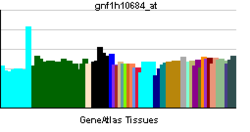- OR52M1
-
Olfactory receptor, family 52, subfamily M, member 1 Identifiers Symbols OR52M1; OR11-11; OR52M1P; OR52M3P External IDs MGI: 3030388 HomoloGene: 105158 GeneCards: OR52M1 Gene Gene Ontology Molecular function • receptor activity
• olfactory receptor activityCellular component • plasma membrane
• integral to membraneBiological process • sensory perception of smell
• response to stimulusSources: Amigo / QuickGO RNA expression pattern 
More reference expression data Orthologs Species Human Mouse Entrez 119772 258322 Ensembl ENSG00000197790 ENSMUSG00000073971 UniProt Q8NGK5 Q8VEX9 RefSeq (mRNA) NM_001004137 NM_146325.2 RefSeq (protein) NP_001004137 NP_666437.2 Location (UCSC) Chr 11:
4.57 – 4.57 MbChr 7:
109.79 – 109.79 MbPubMed search [1] [2] Olfactory receptor 52M1 is a protein that in humans is encoded by the OR52M1 gene.[1]
Olfactory receptors interact with odorant molecules in the nose, to initiate a neuronal response that triggers the perception of a smell. The olfactory receptor proteins are members of a large family of G-protein-coupled receptors (GPCR) arising from single coding-exon genes. Olfactory receptors share a 7-transmembrane domain structure with many neurotransmitter and hormone receptors and are responsible for the recognition and G protein-mediated transduction of odorant signals. The olfactory receptor gene family is the largest in the genome. The nomenclature assigned to the olfactory receptor genes and proteins for this organism is independent of other organisms.[1]
Contents
See also
References
Further reading
- Gilad Y, Lancet D (2003). "Population differences in the human functional olfactory repertoire.". Mol. Biol. Evol. 20 (3): 307–14. doi:10.1093/molbev/msg013. PMID 12644552.
- Malnic B, Godfrey PA, Buck LB (2004). "The human olfactory receptor gene family.". Proc. Natl. Acad. Sci. U.S.A. 101 (8): 2584–9. doi:10.1073/pnas.0307882100. PMC 356993. PMID 14983052. http://www.pubmedcentral.nih.gov/articlerender.fcgi?tool=pmcentrez&artid=356993.
External links
This article incorporates text from the United States National Library of Medicine, which is in the public domain.
Class I
(fish-like specific receptors)Family 51Family 52Family 56Class II
(tetrapod specific receptors)Family 1Family 2A1 · A2 · A4 · A5 · A7 · A12 · A14 · A25 · A42 · AE1 · AG1 · AG2 · AJ1 · AK2 · AP1 · AT4 · B2 · B3 · B6 · B8 · B11 · C1 · C3 · D2 · D3 · F1 · F2 · G2 · G3 · G6 · H1 · H2 · J1 · J2 · J3 · K2 · L2 · L3 · L5 · L8 · L13 · M2 · M3 · M4 · M5 · M7 · S2 · T1 · T2 · T3 · T4 · T5 · T6 · T8 · T10 · T11 · T12 · T27 · T29 · T33 · T34 · T35 · V1 · V2 · W1 · W3 · W5 · Y1 · Z1
Family 3Family 4Family 5Family 6Family 7Family 8Family 9Family 10Family 11Family 12Family 13
This transmembrane receptor-related article is a stub. You can help Wikipedia by expanding it.
